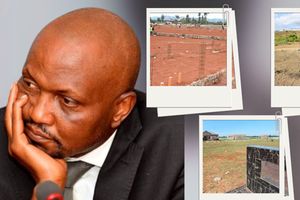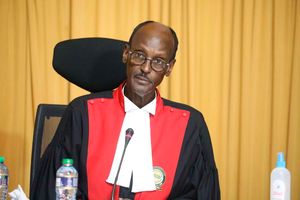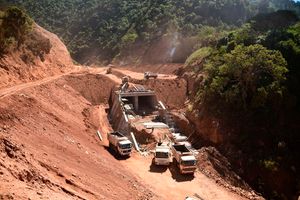Premium
Bogged down by poverty, pandemic and insecurity yet unbowed
Outside his family shack in Galjal, Garsen Sub County in Tana River County, Athan Mohamed tunes in to a local radio station. It’s Saturday afternoon, and like the rest of learners across the country, the Standard Four pupil at Abaganda Primary School has to keep up with radio lessons.
Mohamed though has to contend with a feeble signal, disruptive wind and baking sun to follow the one-hour session. He has done this for eight months now.
For every day that Chalet Wario stays away from school, her dream to become a journalist is scattered away. For the Standard Four pupil at Idsowe Primary School, these fears aren’t misplaced. Already, tens of her peers have been married off while boys have turned to herding and fishing.

Fatma Bahola, a community teacher in Abaganda, Tana River County.
At this village in Tana Delta Sub County, not a single case of Covid-19 has been recorded nearly eight months since the pandemic struck. But its devastation to learners is evident. Without community interventions, education for tens of children here would be in limbo.
Henry Komora, the village headman, is a concerned man. Teenage pregnancies and crime rates have surged in the locale recently.
‘‘Schools were protecting our children. [Covid-19] has not only made learning more difficult but it’s also exposed them to harm,’’ Komora lamented.
He told the Nation that for months now, he and other elders have been facilitating counselling and awareness programmes, just to keep their children out of mischief.
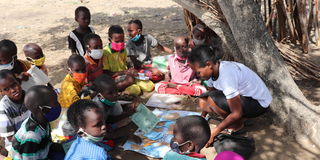
Valentine Nzogolo, a volunteer teacher at Abaganda in Tana River County, takes learners through a lesson.
Tough battle
At Sheli, a village in the outskirts of Minjila along the Malindi-Garissa highway, Garsen, a group of 20 pupils sit on a rug under a tree, reading for their Kiswahili lesson. A blanket of dust sweeps by, scattering their learning material. For several minutes, learning stops as the children and their teacher, Ms Sabina Kiambati, take cover.
While schoolchildren in other parts of the country have been participating in e-learning sessions through radio and the web, for their peers in Bura, Galole and Tana Delta sub counties, it has been an unnerving battle of trying to catch up for months.
In this arid and semi-arid (ASAL) county ravaged by pervasive poverty, occasional drought, insecurity and scanty resources, education has been slack for decades. Findings of a national assessment of learning levels among schoolchildren in Kenya in 2013 (Uwezo Report) ranked Tana River among the bottom 10 counties countrywide.
Most households here do not have a radio or a mobile phone, let alone a television set. This limits their access to and participation in remote learning programmes by the Kenya Institute of Curriculum Development (KICD).
For children with learning challenges such as Hamud Galgalo, 12, the complexity is tenfold. Every day spent away from school is a nightmare for the Standard Five pupil at Sheli Primary School.
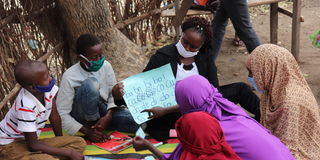
Teaching assistant Sabina Kiambati takes learners through a language lesson at Sheli in Garsen, Tana Delta, in Tana River County.
Slow learners
Without the necessary countermeasures, most slow learners drop out of school out of frustration, according to Peter Mainga, the Teachers Service Commission (TSC) director of education in Tana Delta Sub County.
In 2013, the government banned grade repetition through Section 35 of the Basic Education Act (No 14). Consequently, learners go up the classes with deficiencies. According to Mainga, those fortunate to finish their studies are often neither able to read nor solve simple numeracy problems.
In Tana River County, education stakeholders, community organisations and administrators are working to save their children’s education from collapse.
From volunteer teachers to local radio learning programmes to sensitisation, communities here are sparing no effort to keep learning going.
At Galili Primary, for instance, parents have mobilised resources to hire teachers just so that their children can continue to learn.
Elsewhere in Galma Location, a remote village in Garsen, area Chief Omar Ibrahim has been teaching pupils at his home, besides his administrative duties.
Other interventions include an accelerated learning programme (ALP) by ziziAfrique Foundation –a community-based organisation that promotes equity in education –targeting children with learning challenges.
Through community teaching assistants, workbooks and radios, this grassroots ALP –which is supported by Safaricom Foundation –has been the hope for many learners and their parents in the county.
‘‘We opted for community-based interventions that address the nature and level of need. We started by providing radios to enable the learners to access lessons,’’ says Virginia Ngindiru, the project manager at ziziAfrique.
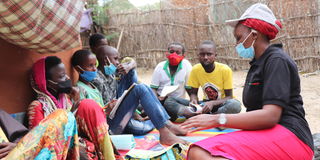
Virginia Ngindiru, a community mobiliser, goes through a lesson with learners at Garsen in Tana River County. Her organisation, ziziAfrique, offers accelerated education for slow learners in the area.
Accelerated learning
Accelerated learning models such as the Combined Activities for Maximised Learning (CAMal) have proved fast and effective for children with learning challenges.
In Turkana, Bungoma and Tana River counties where CAMal was piloted in 2018, 44 per cent of pupils aged between six and 16 who couldn’t initially read were able to do so after being exposed for only four weeks.
‘‘Identifying a child’s learning challenges early is critical because then you’re able to provide the appropriate interventions. This propels the child to the subsequent level of learning with ease,’’ Ngindiru notes.
While these invigilated education programmes initially targeted slow learners, more parents have requested to have their children admitted, thus straining resources. Communities here have remained relentless.
For the last seven months, Dorothea Mueni, the head teacher of Sheli Primary in Garsen, has mobilised her teachers to assist learners in the community. To her, community intervention programmes are sacred, and the surest way to salvage the education of hundreds that now hangs in the balance.
‘‘Most of our learners had literacy and numeracy challenges. By staying at home for a long period, we feared they’d lose whatever they had learnt,’’ Mueni said.
UNESCO warned in August that after nearly six months out of school, children risked losing 0.6 years of learning. Notably, the majority of Kenyan learners were last in school eight months ago.
With return to learning still cast in uncertainty, Ngindiru warns that more academic loss is inevitable, especially for slow learners who face total erosion of knowledge.
Last week, President Uhuru Kenyatta ordered the Ministry of Education to kickstart plans to reopen schools in January 2021. The planned resumption though hinges on the country’s ability to contain the spread of the surging pandemic.
When schools closed in March in the wake of Covid-19, it marked the end of education for hundreds of schoolchildren in Tana River County. But communities are determined to salvage their children’s education at whatever cost.
For now though, the priority for Komora, Chief Omar Ibrahim at Galma and other community elders in Tana River County remains to keep their children out of mischief.
Factbox
- At only 21 per cent, adoption of family planning in Tana River County remains low: National Council of Population and Development (NCPD).
- Most families here have between four and seven children, which leads to overcrowding in schools.
- Some classes have up to 90 learners in a class, with learners in different grades sometimes sharing classrooms in some schools.
- This complicates individual attention to pupils, thus disadvantaging slow learners.
- E-learning can’t help to recover school lost hours of learning: Survey on Socioeconomic Impact of COVID-19 on Households.
- Nearly 10 million learners globally may not go back to school after the crisis: Save the Children.



